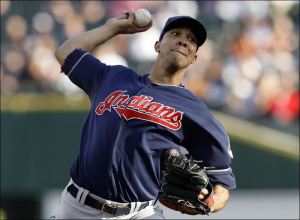by Sam Waters
This post also appeared on baseballanalytics.com here.
Let’s get right to the point- Ubaldo Jimenez has been terrible this year. Really, really terrible. Of course, May is usually a little too early to panic about any pitcher’s performance. Other high-profile hurlers like Tim Lincecum, Mike Minor, and Clay Buchholz all have worse ERA’s. When it comes to this underperforming trio though, their strikeout and walk rates point to better days ahead. Jimenez does not evoke the same sense of optimism.

Ubaldo Jimenez is walking more batters than he strikes out. To put that in context, not a single qualifying starter in 2011 managed that “feat”. The only pitchers that did manage more walks than K’s didn’t reach the qualifying innings limit, because no pitcher that bad could be allowed to stick in an MLB rotation for an entire season. Ubaldo’s 5.3 K/9, 6.75 BB/9, and 39.2 GB% give him a 5.97 skill-independent ERA (SIERA), good for last in the MLB by a wide margin. (The next closest pitcher, Barry Zito, has been almost a run better with a SIERA of 5.06.) Let’s take a look at the differences between Jiminez today and Jiminez in 2010, when he finished third in the NL Cy Young voting with a 2.88 ERA.
Jimenez’s league-worst walk rate might suggest that he has lost command of the strike zone. While listening to Indians games on the radio, I’ve heard the broadcasters confirm this idea many times, suggesting that Jimenez has no idea where the ball is going. A look at the percent of pitches Jimenez is putting in the strike zone dispels that notion, however. He is actually hitting the strike zone more this year, increasing his 2010 zone rate of 44.8% to 47.7% in 2012. The real issue is an inability to fool hitters on pitches out of the zone, stemming from a loss of velocity.
In his prime, Jimenez relied heavily on his overpowering fastball, the fastest among qualifying starters in 2010. Back then, he sat at an average of 96.1 MPH. This year his average fastabll velocity is down to 92.3 MPH, falling even further after an initial drop in 2011. In fact, the average velocity on all four of his main pitches is down 2-4 MPH. Jimenez’s fastball and changeup have been a lot less deceptive coming in at slower speeds. Hitters are just not chasing these pitches outside of the strike zone any more, and when they do, they are making contact more often and with more authority.

The decreases in chase percentage seen above for both fastballs and changeups actually leave Ubaldo at last in the majors in swing percentage outside of the zone. As you can see, when hitters do chase outside the zone, Ubaldo has gone from being an extreme ground ball pitcher on changeups to an average one, while seeing a significant increase in line drives on both pitches.
All of this adds up to a bleak outlook for Jimenez over the rest of the season. Without his trademark velocity, he seems incapable of forcing hitters to chase his fastball or changeup. He has gone from generating swing-and-misses and inducing grounders on these outside pitches to throwing balls and surrendering line drives. Jimenez needs to get his velocity back closer to past levels to reverse this trend and regain his effectiveness. The fact that this downward trend in velocity has been developing since last year though, is ominous. The Indians have to hope that the issue is a correctable mechanical flaw and not a natural age-related decline. If the life on his fastball is really never coming back, Jiminez is going to have to completely reinvent himself as a pitcher. If he doesn’t make this dramatic turnaround soon, the Indians will be forced to look for another option in the rotation as they attempt to stave off the White Sox and Tigers in the AL Central.
